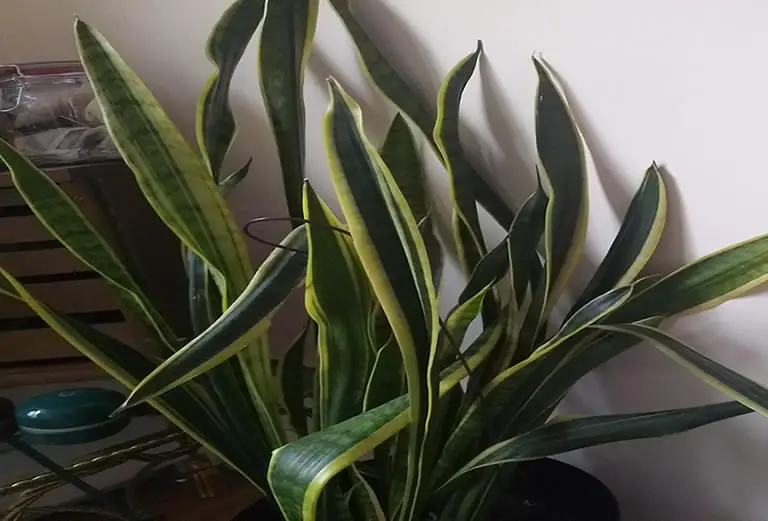You chose a snake plant for your garden or as an indoor potted houseplant, because you heard the plant was difficult to kill. Yet fast-forward a few months and your snake plant definitely seems like it’s dying. What’s causing your snake plant’s poor health and how do you save it? In this article I will address the 4 main causes for snake plant death and show you how to avoid them and also how to treat plants already suffering from them.
Table of Contents
- Why is my snake plant dying?
- The 4 causes for a snake plant dying and what to do about them
- Conclusion to why your snake plant is dying
Why is my snake plant dying?
There are 4 possible causes for why your snake plant is dying:
- Root rot from overwatering
- Temperature extremes around the plant
- Infections/diseases
- Pest infestations.
All can be successfully treated if caught before too much damage is done to the plant roots.
Any of the 4 main causes of poor health in a snake plant that are covered in this article can eventually kill your plant.
However, just because you find one cause be sure to look for others as it is possible there could be more than one problem with the plant.
The 4 causes for a snake plant dying and what to do about them
This is a quick overview of the article for reviewing later.
However, I urge you to read the entire post before taking any steps to treat your plant.
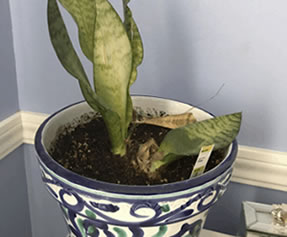
Why your snake plant is dying – the 4 main causes:
- Pests.
- Disease.
- Temperature extremes.
- Root rot (due to overwatering).
Pests, diseases, temperature extremes, and overwatering can all kill your snake plant.
Here are some fixes to cure your dying snake plant:
- Check frequently for infections and infestations.
- Don’t reuse potting soil.
- Maintain consistent temperatures.
- Water your snake plant only when its soil is dry.
If your snake plant is on the brink of death, you might be able to bring it back by following the treatment and prevention methods we’re about to discuss.
At the very least, investigating your the cause of plant’s health issues and following our advice will mean you’ll know which care facets you should follow for your future snake plants even if your current one is beyond saving.
So, let’s get started.
1. Snake plant dying due to pest infestation
Pests are the blight all of types of plants whether they are indoor or outdoor. Let’s look at the possible pest infestations that can affect a snake plant.
The problem with snake plant pests
It doesn’t matter whether you grow your garden indoors or outdoors, pests are an unavoidable issue.
Snake plants are known to lure in several types of pests, including the common spider mites, aphids, whiteflies, mealybugs, fungus gnats, and scale.
Let’s discuss each of these unwanted insects now.
- Spider mites: With roughly 1,200 spider mite species, almost every gardener has dealt with spider mites at one time or another. The nearly microscopic insects will position themselves and nestle in under a plant’s leaves going unnoticed until they start creating havoc on the plant. They weave trademark webs and feed on the plant’s juices until it’s resources are depleted.
- Aphids: Known as the blackfly or greenfly, the aphid are similar to spider mites in that they suck on the sap of plants. When female nymphs are born, some start pregnant, which increases the risk of an infestation. The females will eventually grow wings so they can spread from plant to plant.
- Whiteflies: Another snake plant pest is the whitefly, of which there are well over 1,500 species. The tiny insects – which are not always white – can fly. As they continue to drink-up plant sap, whiteflies will deposit a sticky residue known as honeydew (which has no negative effect on the plant). When you see honeydew on leaves you know you have whiteflies on the plant. As well as consuming important resources the whitefly can act as a vector for diseases as well thus posing a two-fold problem for your plant.
- Mealybugs: A type of scale insect, the mealybug prefers warm, moist environments. Snake plants aren’t necessarily humidity lovers, but they can excel in the type of warmer conditions that attract mealybugs. Mealybugs thirst for the juices of subtropical plants, houseplants, and greenhouse plants so they love snake plants. They too will spread disease in their wake as well as stripping the pant of resources.
- Fungus gnats: Although they don’t live long, when a fungus gnat is alive, it can wreak a lot of havoc on a plant. They can spread the pythium disease to other plants and grass. You’re more likely to find fungus gnats in the soil of your plant than on its leaves. Your plant will display symptoms of root rot when attacked by fungus gnats.
- Scale: The last species of insect that can invade a snake plant is the scale insect. As some of the smallest bugs around, scale bugs can be hard to detect. Some species of scale can produce waxy coatings for protection since they don’t fly.
How to stop your snake plant dying from pests
Once you’ve determined that your snake plant is succumbing to an infestation as caused by one of the above insect species, you must remove the bugs immediately.
In my opinion you should put aside the chemical insecticides as they are bad for the environment and harsh on plants.
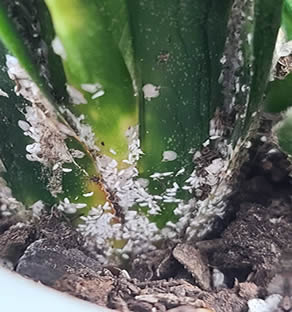
Many small insects can’t survive a simple cotton swab or cotton ball that’s dipped in 70-percent isopropyl alcohol or a little dish soap.
Others can be flicked off by hand (which yes, it is gross but it is doable) or even rinsed away with a spray bottle or a gardening hose.
If you have a bad infestation or feel that you need something stronger than alcohol or soap then go for a natural organic insecticide to lessen your impact on the environment and your plant.
If you detect fungus gnats in the soil then you will also have to treat the plant for root rot (as outlined below).
These nasty little critters attack the roots and produce similar problems to other root related diseases and so need to be treated in the same way.
If your plant is infested, then you must sequester it from the rest of your garden or move it away from other houseplants so the infestation and/or diseases cannot spread.
In the future, whenever you bring home a new plant, inspect it thoroughly for signs of insect infestations.
Continue checking your plant weekly to ensure that critters haven’t taken over.
2. Snake plant dying due to disease
Diseases in plants are very common.
Houseplants are just as susceptible to infection as outdoor plants.
Diseases that affect snake plants
Diseases are another major killer of snake plants. The snake plant, botanical name Sansevieria trifasciata, can fall prey to such diseases as red leaf spot and southern blight.
Red leaf spot requires wet, warm conditions to occur. So humid environments offer an excellent breeding ground for this plant disease.
It is the fungi Helminthosporium which causes the disease in the plant. When this fungi takes hold spores will develop on your snake plant’s foliage, which is the biggest symptom.
The spores create areas of discoloration that look like reddish spots on your snake plant’s leaves.
The spots usually have a tan or brown middle, at least at first.
If the spots (which are actually lesions) are left to grow, then the blade-like leaves of your snake plant can begin falling off one by one.
Southern blight is also a fungal disease that’s common in subtropical, and also tropical, plants.
It is the Sclerotium rolfsii fungus which causes the disease in the plant.
Moisture and warmth can foster southern blight, much the same way it causes red leaf spot.
The symptoms of southern blight include leaf wilting and discoloration.
Without treatment, the leaves of your snake plant will collapse, and the plant will die soon after.
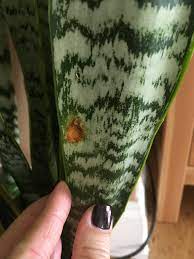
In some cases, fungal filaments such as mycelia and hyphae might develop around the base of the snake plant and in its soil.
The white filament color will make the fungi distinct.
If southern blight has advanced to that degree, then you cannot keep your snake plant in the same soil anymore and you must repot it after you have the treated the plant.
How to treat diseases in snake plants effectively
If you’ve diagnosed your snake plant with a case of red leaf spot or southern blight, then you must take steps to control the humidity levels around your plant.
As I touched on earlier, the snake plant doesn’t require high humidity.
By reducing humidity levels around the plant you will reduce the temperature.
The lack of warm moist air will prevent fungi from growing as they thrive on moisture.
If it’s too late to prevent these diseases, then use a good organic fungicide for about two weeks and you should see major improvement.
By then, your plant’s conditions should clear up, provided of course, that the disease is not too advanced.
Consider repotting the snake plant once it has started to recover.
I wouldn’t repot it immediately unless you caught the problem very early and there are only small signs of problems; you don’t want to stress the plant any more than it already is.
3. Snake plant dying due to temperature fluctuations
A snake plant, like all plants, has specific temperature ranges that it can tolerate.
While many other plants, especially houseplant, will merely stop growing, refuse to bloom or go limp when they encounter incorrect temperatures, extremes in temperatures can kill a snake plant.
How extreme temperatures affect snake plants
Further attesting to its seemingly unkillable nature, the snake plant can withstand a variety of temperatures, or at least, that’s what you’ve heard … right?!
Well it may be true to an extent that a snake plant can tolerate a range of temperatures, like every other plant it has its own hot and cold tolerances.
The ideal temperature range for the snake plant is 60°F to 75°F.
Since that’s average room temperature, there’s usually no need to adjust your thermostat for the snake plant or use a grow light or heat pad as you might need to do with other indoor succulents.
Once the temperatures reach the low 30s and frost develops on outdoor surfaces, your snake plant cannot remain outside.
Even if it’s usually an outdoor plant, it’s time for the snake plant to come inside for the winter.
In very cold temperatures, snake plants can experience cold stress. In such instances the leaves of your snake plant will noticeably sag.
That deep rich green color of the foliage will fade, and the leaves can even fall off.
Vein color changes and black spots on your plant are both indicative that frost has killed the plant cells there.
The leaves may also start to split.

Too much of this damage can be irreversible for your snake plant but the plant can recover if the problems are noticed early and steps are taken to protect the plant.
Snake plants have far greater heat tolerance than they do cold tolerance, as the plant can withstand temperatures up to 104°F.
As it will rarely, if ever, get that warm indoors you have no need to worry.
In most areas of the US you can be confident that your Sansevieria snake plant will survive easily in hot summers outside.
That said, if it’s the middle of the summer and your snake plant is wilting, it’s likely too hot.
The sun will most likely have dehydrated your poor plant.
Further exposure to the high heat will cause a browning and crisping of the leaves. If the snake plant is not moved to a cooler location it will eventually lead to the death of the plant.
How to ensure the correct temperature for your snake plant
Maintain temperatures as close to the snake plant’s preferred range as you can – 60°F to 75°F.
As I stated above, the snake plant thrives in a room temperature environment, so there is no need to make special temperature considerations for your Sansevieria.
If your snake plant has suffered the effects of cold shock, bring it indoors immediately.
Put the plant in a warm spot in your home and leave it be for several days.
Continue other care facets like watering the snake plant, but otherwise, give it time.
After a few days when the plant has started to customize to the higher temperature, consider using a small grow light to give the plant additional heat.
This will also provide it with additional light to help in its recovery. Don’t use a grow light immediately upon moving the plant or you may shock it.
It can take weeks and sometimes months to see significant improvement (faster with a grow light), but your snake plant should bounce back from cold shock and make a full recovery.
If it’s heat stress that’s afflicting your snake plant, then you again have to bring the plant indoors immediately.
Put it in a cool, shaded spot and give it a nice drink of cool water, as the snake plant is more than likely dehydrated.
Continue watering regularly but not to excess (more on this in a moment).
Keep the temperatures cool and closer to the lower range of the plant’s tolerances and your snake plant should eventually come back to life.
4. Snake plant dying due to incorrect watering
Watering succulents is probably the most important aspect of their care.
More so than most other houseplants, succulents are very susceptible to water-related problems.
Keep in mind that succulents usually grow naturally in water-scarce environments and most have evolved to live on much less water than the other types of plants that you grow as houseplants.
Just remember that they rarely need watered as much as your other plants!
I have a detailed guide to snake plant watering which you should considered reading after this article.
Overwatering can lead to a snake plant dying due to root rot
The snake plant can handle fluctuating temperatures and humidity even though it doesn’t really require it.
One area of its care though in which the snake plant is very intolerant is watering.
Getting the watering routine of this succulent correct is essential.
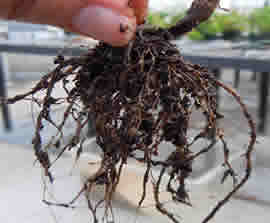
If you overdo it on the water, you could very soon have a dead snake plant on your hands.
Overwatering is a common mistake among indoor and outdoor gardeners alike.
Many plant lovers don’t know how much water their plant needs, so they assume they should water them every single day.
Indoor plant owners will also often water all their plants at the same time and with the same regularity.
Succulents, like the snake plant, do require water, but only so much of it and much less than evergreens or other common houseplants.
When you flood your snake plant with water, you’re trapping water in the soil.
The air pockets throughout the soil that provide oxygen to the plant are now choked out and unable to hold much needed air. But it gets even worse than that!
The standing water built-up in the soil also causes the plant’s roots to rot and die.
The roots lose their firm texture and will turn black and mushy; they also smell horrible.
As the root death occurs or shortly thereafter, your plant will begin manifesting symptoms such as wilted leaves and slowed growth.
Root rot, although caused by excess water in the soil, actually leads to the dehydration and starvation of your snake plant.
As the roots rot, they become unable to absorb moisture and nutrients from the soil. Thus, they cannot distribute those resources to the rest of the plant causing dehydration and starvation.
The correct water routine to stop a snake plant dying
The best way to determine when to water any plant, snake plant or otherwise, is to put your fingers a few inches in the soil and feel how dry it is. I call this the finger test.
If the first inch of the snake plant’s soil is completely dry then your finger will be clean when you remove it from the soil.
If your finger has a lot of dirt stuck to it then the soil is still moist and it’s time to water your plant.
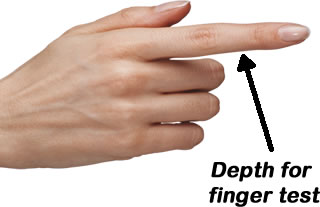
If the soil still feels moist, then you shouldn’t water your snake plant yet.
That’s all there is to it.
Snake plants are moderately drought-tolerant, so you’re better off waiting longer to water the plant than you are watering it too much.
What if your snake plant is in the throes of root rot?
If you suspect your snake plant is suffering from root rot then you need to remove the plant from its soil immediately so you can inspect the root ball.
Depending on the health of the root ball, you might be able to save your snake plant though you might not if the root damage is extensive.
If the roots are predominantly black, then the root rot is severe and your plant may be past saving.
That said, if you see more white roots than black ones, you should remove the black roots using clean gardening shears or a sharp knife.
Once you have cleaned up the root ball transfer your snake plant to a new pot (or put it back into its original pot that has been thoroughly cleaned).
Use fresh soil and begin watering it only when that soil is dry.
If you require very detailed steps for treating root rot read my instructions for treating aloe vera root rot. The steps involved for treating aloe root rot are exactly the same for other succulents including the snake plant.
Conclusion to why your snake plant is dying
The snake plant’s reputation of invincibility has led to many beginner gardeners to take actions that have resulted in the accidental death of their plant.
Although the snake plant can tolerate a lot, like every living organism, it too has its limits.
Now that you know what those are, you can create a care plan so your Sansevieria grows healthy and beautiful!

